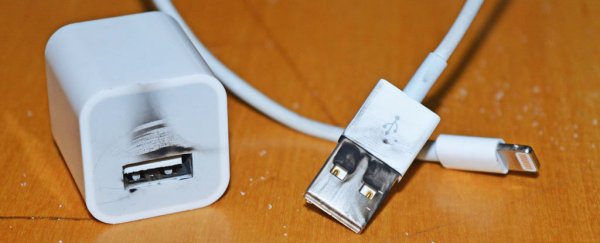The dangers of faulty smartphone batteries have been well documented this year, but new research in Canada shows that there's another hidden threat affecting our use of mobiles – and the scale of the problem is worse than anybody realised.
In an examination of 400 counterfeit Apple iPhone chargers bought online, more than 99 percent of the imitation devices failed a basic safety test, with just three offering sufficient insulation to protect against the risks of an electric shock.
The new study, carried out by the Canadian division of power safety compliance firm UL, shows that these counterfeit products aren't just cheap knock-offs – dodgy components and manufacturing means they could be deadly too.
The researchers bought 400 counterfeit iPhone chargers from online sellers in eight countries, including the US, Canada, Colombia, China, Thailand, and Australia.
With the devices in hand, they subjected them to an electric strength test, in which the units were stressed by applying a high voltage between the input and the output side, to see how much current flows in the charger.
If the amount of current is above a certain threshold, the device is considered to have failed the test, as insufficient insulation means it could pose a risk of shocking a user.
In the results, only three devices out of 400 examined passed the safety test – but the results were even worse than that.
Some 22 of the units were immediately damaged upon energising them (which in turn damaged some of the testing equipment), and 12 of the samples demonstrated very high current leakage that could potentially electrocute a person.
The extremely high failure rate is kind of staggering when you think about it – almost 100 percent of these things could be considered dangerous, at least based on a sample of 400 products.
But the problem of dangerous chargers isn't anything new.
Counterfeit iPhone chargers have been tied to the deaths of numerous people in recent years, and in October it was revealed that Apple's own research found that almost 90 percent of "genuine" Apple power products sold on Amazon were counterfeit.
But why are these devices so dangerous? According to the researchers, the major problems are issues with the design of the devices' isolation transformers:
"The internal components are vastly different when compared with a genuine UL Listed Apple adapter. Post testing analysis of the tested samples revealed a complete lack of triple isolation wire used for the secondary windings; neither the primary or secondary windings were separated properly, which is the major reason for the dramatic failure rate on the electric strength test."
These components are crucial in helping genuine chargers safely take an input voltage from your power outlet – ranging from 100 to 240 V AC – and converting it to 5 V DC.
As the researchers point out, companies like Apple or other reputable third-party brands will rigorously test their devices to make sure that they do this function safely and consistently – but as for those cheapie devices or counterfeit products, there's no guarantee of quality, safety, legitimacy, or really anything at all.
To tell genuine Apple iPhone chargers from counterfeit products, the researchers say the genuine article will always be white in colour, not featuring other colours.
Packaging should also be white and Apple-branded – not sold loose, or with the product contained in other kinds of packaging.
Look out for spelling or grammatical mistakes in any printed text (genuine products won't have any).
And perhaps the biggest indication is price – if you got it for significantly less than US$19 new (what Apple charges for its official product), it might not be the bargain you hoped for.
We might not think all that much about how we use our smartphone chargers, but it's obvious they perform a critical role in our lives – topping our smartphones up with juice on a daily basis, and most importantly, doing it safely.
And let's face it, it sucks how much Apple demands for genuine charger products, but judging from these results, the alternative probably isn't worth it.
The report is available on UL's website.
